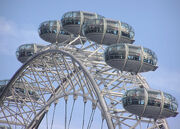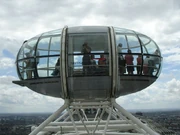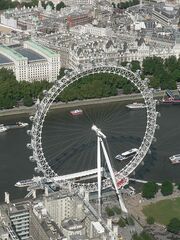The 'London Eye (Millennium Wheel) at a height of 135 metres (443 ft), is the biggest Ferris wheel in Europe, and has become the most popular paid tourist attraction in the United Kingdom, visited by over 3 million people a year. At the time it was erected it was the tallest Ferris wheel in the world, until it was surpassed by the Star of Nanchang (160m) in May 2006, and then the Singapore Flyer (165m) on February 11, 2008. However, it is still described by its operators as "the world's tallest cantilevered observation wheel" (because the entire structure is supported by an A-frame on one side only).
The London Eye is located at the western end of Jubilee Gardens, on the South Bank of the River Thames in London, United Kingdom, between Westminster Bridge and Hungerford Bridge. The site is adjacent to that of the former Dome of Discovery, which was built for the Festival of Britain in 1951.
Design and construction

Each of the 32 capsules holds approximately 25 people.

The Eye's bicycle wheel-like appearance
Designed by architects Jack Finney, Julia Barfield, Malcolm Cook, Mark Sparrowhawk, Steven Chilton and Nic Bailey, the wheel carries 32 sealed and air-conditioned passenger capsules attached to its external circumference. Each capsule holds approximately 25 people, who are free to walk around inside the capsule, though seating is also provided. It rotates at 26 cm (10 in) per second (about 0.9 km/h (0.5mph) so that one revolution takes about 30 minutes. The wheel does not usually stop to take on passengers: the rotation rate is so slow that they can easily walk on and off the moving capsules at ground level. It is, however, stopped to allow disabled or elderly passengers time to embark and disembark safely.

Eye Capsule at the top of the rotation
The rim of the Eye is supported by tie rods and resembles a huge spoked bicycle wheel, and was depicted as such in a poster advertising a charity cycle race. The lighting for the London Eye was redone with LED lighting from Color Kinetics in December 2006 to allow digital control of the lights as opposed to the manual replacement of gels over fluorescent tubes.
Mace were responsible for construction management with Hollandia as the main steelwork contractor and Tilbury Douglas as the civils contractor. Consulting engineers Tony Gee and Partners designed the foundation works while Beckett Rankine designed the marine works. The wheel was constructed in sections which were floated up the Thames on barges and assembled lying flat on piled platforms in the river. Once the wheel was complete it was raised into an upright position by a strand jack system, being lifted at 2 degrees an hour until it reached 65 degrees. It was left in that position for a week while engineers prepared for the second phase of the lift. The total weight of steel in the Eye is 1,700 tonnes (1,870 short tons). The project was truly European with major components coming from six countries: the steel was supplied from the UK and fabricated in The Netherlands by the Dutch company Hollandia, the cables came from Italy, the bearings came from Germany, the spindle and hub were cast in the Czech Republic, the capsules were made by Poma in France (and the glass for these came from Italy), and the electrical components from the UK. (Mann, Thompson, Smits, 2001)
Credit

An aerial view of the London Eye
The credit should go to Owen Johnson and Paul Tame.
Financial controversy
On 20 May 2005, there were reports of a leaked letter showing that the South Bank Centre (SBC) — owners of part of the land on which the struts of the eye are located — had served a notice to quit on the attraction along with a demand for an increase in rent from £64,000 per year to £2.5 million, which the operators rejected as unaffordable.[6]
On 25 May 2005, London mayor Ken Livingstone vowed that the landmark would remain in London. He also pledged that if the row were not resolved he would use his powers to ask the London Development Agency to issue a compulsory purchase order.[7] The land in question is a small part of the Jubilee Gardens, which was given to the SBC for £1 when the Greater London Council was broken up.
The South Bank Centre and the British Airways London Eye agreed a 25-year lease on February 8, 2006, after a judicial review over the rent row. The lease agreement meant that the South Bank Centre, a publicly-funded charity, would receive at least £500,000 a year from the attraction, the status of which is secured for the foreseeable future. Tussauds also announced the acquisition of the entire one-third interests of British Airways and the Marks Barfield family in the Eye, as well as the outstanding debt to BA. These agreements gave Tussauds 100% ownership of the Eye and resolved the debt from the Eye's construction loan from British Airways, which stood at more than £150 million by mid-2005 and had been increasing at 25% per annum.
Predecessor
A predecessor to the London Eye, called the "Great Wheel of London", was built in Earl's Court in 1895 and was capable of carrying 1,600 people. It closed in 1906, and was demolished in 1907.
Capsule sight seeing
A photograph of passengers in the capsule is taken automatically as they approach the end of the flight. It takes around 30 minutes to complete its revolution with speed of 0.26 m/s/0.85 ft/s. Tickets can be booked in advanced or depending on availability on arrival at the eye.